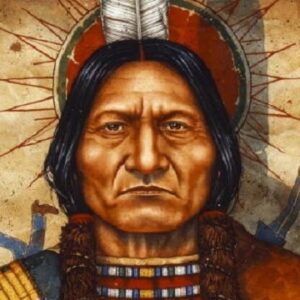Sitting Bull was a Teton Dakota Indian chief who fought for the Sioux tribes’ survival on the North American Great Plains. He was a Hunkpapa Lakota holy man who developed a lifelong dislike for white men and actively opposed US government policies as a tribal chief. He was born into the Teton Sioux’s Hunkpapa division and grew up to be a fearless and brave young man. He joined a war party when he was barely out of his teens and quickly rose to prominence as a leader of the powerful Strong Heart warrior society. He was also involved in tribal welfare and rose to prominence as a valiant tribal chief who assisted in the expansion of the Sioux hunting grounds westward into territory previously occupied by the Shoshone, Crow, Assiniboin, and other Indian tribes. He developed hostility toward the United States army when it began invading Sioux hunting grounds, and clashes with the army intensified in the mid-1870s when gold was discovered in the Black Hills, a region sacred to Native Americans. Sitting Bull was extremely distrustful of white men, who repeatedly violated the Native Americans’ rights, and fought valiantly against the United States government’s policies. He fought for natives’ rights to the bitter end, and was assassinated by police officers hired by United States Indian agents as the authorities grew fearful of him.
Childhood & Adolescence
Sitting Bull was born around 1831 in Dakota Territory to Jumping Bull (father) and Her-Holy-Door (mother) into the Teton Sioux’s Hunkpapa division. He was born Jumping Badger and given the name Sitting Bull as a teenager.
He developed into a skilled warrior and a courageous young man. As a 14-year-old, he joined a group of Lakota warriors on a raiding party to steal horses from a camp of Crow warriors.
Despite his youth, he displayed great courage during the raid, and a ceremony was held following the successful raid to commemorate the boy’s passage into manhood as a Lakota warrior.
He was selected as the leader of the Strong Heart Society of warriors as a young man and later joined the Silent Eaters, a select group concerned with tribal welfare. As a tribal leader, he contributed to the expansion of Sioux hunting grounds.
Later Decades of Bull
He fought his first battle against the United States army in June 1863 and again the following year at the Battle of Killdeer Mountain.
He established himself as a valiant warrior by leading an attack on the newly constructed Fort Rice in what is now North Dakota in 1865. He was appointed principal chief of the northern hunting Sioux the following year, with Crazy Horse, leader of the Oglala Sioux, as his vice-chief.
A wise and fearless leader, he earned widespread respect and was appointed principal chief of the entire Sioux nation in 1867. After years of conflict with the United States army, the Sioux accepted the United States government’s Second Treaty of Fort Laramie in 1868, which guaranteed the Sioux a reservation in what is now southwestern South Dakota.
However, when gold was discovered in the Black Hills in the mid-1870s, white men violated treaty provisions by invading lands guaranteed to the indigenous people. The Sioux resisted the whites’ advance into their land, which enraged the United States government, which declared war on any indigenous tribes that stood in the way of its conquest.
Sitting Bull was greatly agitated by the US government’s betrayal and developed a deep distrust of white men. In 1876, he led a successful battle against American forces, defeating General George Armstrong Custer and all his men in what became known as the Battle of Little Bighorn.
The United States government was humiliated by this defeat and stepped up its efforts to wrest the territory from Native American tribes. The natives fought valiantly under Sitting Bull’s leadership, but the whites’ constant encroachment threatened the tribes’ survival. Dejected and hungry, an increasing number of Sioux people surrendered to US authorities.
Sitting Bull and his remaining followers crossed the border into Canada in May 1877, where they stayed for four years before returning to Dakota territory in 1881. Until 1883, he was imprisoned.
In 1885, he was permitted to leave the reservation and perform with Buffalo Bill Cody’s Buffalo Bill’s Wild West. He achieved celebrity and amassed a modest fortune, which he primarily donated to the less fortunate. He spent four months on the show before returning home.
Significant Combat of Bull
Sitting bull is best remembered for his courage and valor during the Battle of the Little Bighorn, one of the pivotal battles of the 1876 Great Sioux War between the Sioux tribes and the United States. The tribes won the battle by an overwhelming margin, defeating George Armstrong Custer’s US 7th Cavalry.
Personal History and Legacies
According to his tribe’s customs, Sitting Bull had several wives, the most notable of whom were Light Hair, Four Robes, Snow-on-Her, Seen-by-her-Nation, and Scarlet Woman. He fathered a large number of children and also adopted a number of others.
In 1889, Native Americans began spreading the Ghost Dance religious movement, which sought to eradicate white people and reclaim the Native American way of life. Concerned about Sitting Bull’s involvement in the movement, the US authorities dispatched Indian police to arrest him.
On December 15, 1890, the police entered his home and attempted to arrest him. Sitting Bull was killed in the ensuing gunfight.
The United States Postal Service issued a Great Americans series 28 postage stamp featuring a likeness of Sitting Bull on September 14, 1989.
Numerous Hollywood films and documentaries have been made about him and the Sioux culture.
Estimated Net Worth
The net worth of Bull is unknown.


